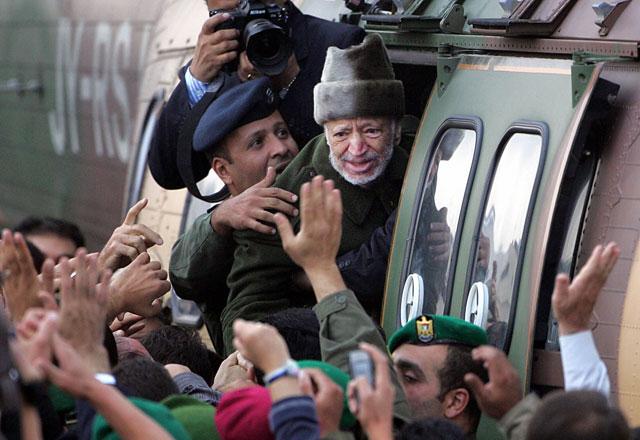You are here
Arafat museum opens in Ramallah, including keffiyehs
By AFP - Nov 09,2016 - Last updated at Nov 09,2016
RAMALLAH, Palestine — The Yasser Arafat Museum opened Wednesday in Ramallah, shedding light on the long-time Palestinian leader's life and offering a glimpse of history — along with a number of his trademark black-and-white keffiyehs.
On display for the first time are a range of Arafat's possessions, including the famous sunglasses he wore when addressing the United Nations in 1974, a number of his iconic keffiyehs (scarfs), his gun and his Palestinian passport.
The museum also traces a century of Palestinian history, including the Nakbah — catastrophe, as Palestinians call the period leading up to and including the 1948 creation of Israel.
Palestinian President Mahmoud Abbas, who succeeded Arafat after his death in 2004, cut the inaugural ribbon at the $7-million museum on Wednesday evening in the occupied West Bank.
It is built behind his mausoleum inside the headquarters of the Palestinian presidency in Ramallah.
Nabeel Kassis, the head of the museum committee, said visitors would learn about the history of the Palestinians "from the beginning of the 20th century until the death of Arafat in 2004”.
He added that the life of Arafat was intertwined with Palestinian history.
"Arafat was closely linked to the struggle of the Palestinian people."
The interactive museum spread over two floors also features videos and photographs of key moments in Palestinian history, some from Arafat's private collection.
The opening comes two days before Palestinians commemorate the 12th anniversary of his death in a hospital near Paris on November 11, 2004, from unknown causes at the age of 75.
Towering figure
The last exhibit guests visit is the small room where Arafat was holed up after Israeli tanks surrounded his headquarters in his final years during the second Palestinian Intifada, or uprising.
It is located in an adjacent building in the same compound, linked to the museum by a bridge.
Inside is the small bed where Arafat, at the time technically the internationally recognised Palestinian leader, spent many of his final days.
There is a picture drawn by his then-infant daughter and a cupboard containing his iconic military uniforms.
Elsewhere there is the room where he was treated before being transferred to Paris as well as the Palestinian, Russian, French and Swiss medical reports on his death.
Images from his funerals in France, Egypt and Ramallah adorn screens on the walls.
A French prosecutor conducted an investigation into alleged poisoning at the request of Arafat's widow Suha, but concluded there was not enough evidence of wrongdoing.
Palestinians accuse Israel of poisoning Arafat, a claim the Israeli government has flatly rejected.
Nobel Prize
Among other items on display is the Nobel Peace Prize which Arafat won in 1994 along with his Israeli negotiating partners Yitzhak Rabin and Shimon Peres for the Oslo accords of the previous year.
It was reclaimed from Gaza, ran by the Hamas movement which rivals Arafat's Fateh, to be displayed in the museum.
Arafat rose to become the leader of the Palestinian movement after the creation of Israel in 1948, leading an armed struggle against it in which thousands died.
Related Articles
NANTERRE, France — A French prosecutor on Tuesday said there was no case to answer regarding the death of Palestinian leader Yasser Arafat,
French judges re-examining the evidence surrounding the 2004 death of Palestinian leader Yasser Arafat have concluded their investigations, the prosecutors office in the Paris suburb of Nanterre said Tuesday.
HEBRON — Confrontations erupted between Palestinians and Israeli forces Monday during demonstrations marking the 15th anniversary of Yasser















